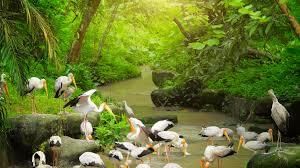Class 7 Geography Notes - Life in the Temperate Grasslands
• Grassland is a region where grasses from the dominant type of plant life.
• Depending upon the climate conditions, grasslands can be divided into two categories, the temperate grasslands and the tropical grasslands.
The Prairies:
(i) The temperate grasslands of North-America are known as the Prairies.
(ii) For the most part, Prairies are tree-less but, near the low-lying areas woodlands can be found. The prairies are bound by the Rocky Mountains in the West and the Great Lakes in the East.
(iii) Prairies cover major parts of USA and Canada.
Climate:
(i) Climate is of continental type with extreme temperature.
(ii) The annual rainfall is moderate and is ideal for the grown of grass.
Flora and Fauna:
(i) Prairies are practically tree-less but the places where water is available, trees such as willows, alders and poplars grow.
(ii) Places that receive rainfall of over 50 cm, are suitable for farming as the soil is fertile.
(iii) Large-scale cattle farms called ranches are looked after by the sturdy men called cowboys.
(iv) Bison or the American buffalo is the most important animal.

Fig: Bison
The Velds:
i) The temperate grasslands of South Africa are called the velds.
ii) Velds are rolling plateaus with varying heights ranging from 600 m to 1100 m.
iii) It is bound by the Drakensburg Mountains on the east.
Climate:
i) The velds have a mild climate due to the influence of the Indian Oceans.
(ii) Winters are cold and dry. Temperature varies between 5°C and 10°C and July is the coldest month.
(iii) The velds receive rainfall mainly in the summer months from November to February.
Flora and Fauna:
i) Vegetation cover is sparse.
(ii) Red grass grows in bush velds.

Fig: Flora and Fauna
People:
i) Velds are known for cattle rearing and mining.
ii) The main crops are maize, wheat, barley, oats and potatoes.
iii) The velds have rich reserve of minerals.
iv) Iron and steel industry has developed where coal and iron present.
v) Johannesburg is known as the gold capital of the world.
FAQs on Class 7 Geography Notes - Life in the Temperate Grasslands
| 1. What is the climate of the Temperate Grasslands? |  |
| 2. What kind of vegetation is found in the Temperate Grasslands? |  |
| 3. What kind of animals are found in the Temperate Grasslands? |  |
| 4. What are the human activities that affect the Temperate Grasslands? |  |
| 5. How can we conserve the Temperate Grasslands? |  |

















